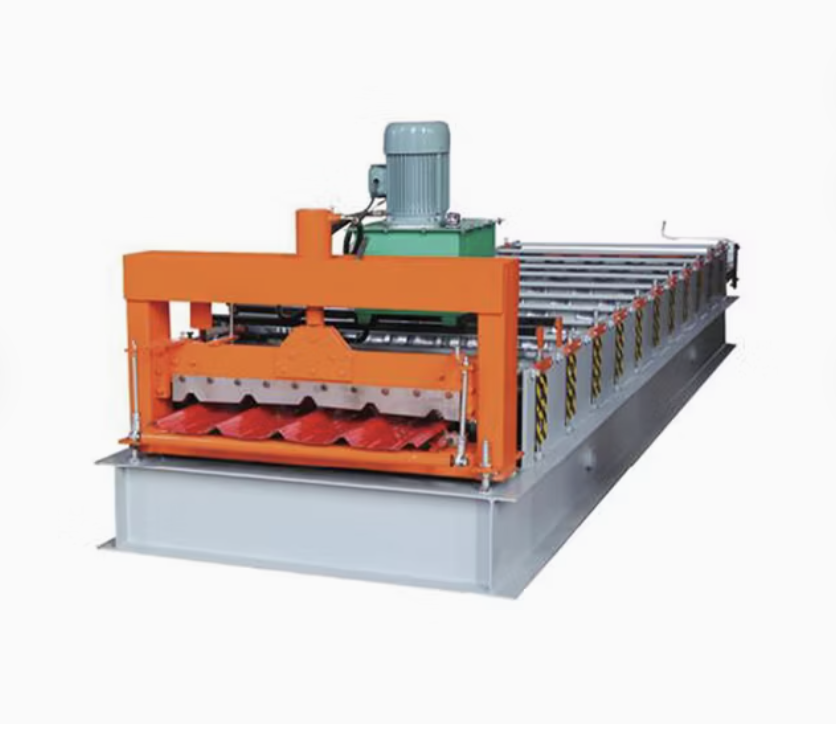To express an interest in this machine please submit the form below.

Not Sure What Machine You Need?
Select Your Profile, We'll Match It
Choose your desired profile drawing, and let Machine Matcher connect you with the best roll forming machine tailored to your needs.
Browse Profiles


Roof roll forming machines are essential equipment in the roofing industry, offering efficient and cost-effective production of metal roofing panels. These machines are specifically designed to shape and cut metal sheets into roofing profiles used in residential, commercial, and industrial structures. They provide precision, durability, and customization, making them ideal for manufacturers looking to meet the demand for various roofing profiles.
A roof roll forming machine operates by feeding a metal coil through a series of rollers that progressively shape the flat metal sheet into the desired roofing profile. These machines are typically designed to handle various types of metals, such as aluminum, galvanized steel, or copper, and can be adjusted to produce different roofing panel shapes, such as trapezoidal, corrugated, or standing seam profiles.
The machine’s core components include:
Roof roll forming machines offer high precision, reduced waste, and consistent quality, which are critical for meeting industry standards and ensuring long-lasting, reliable roofing panels.
Routine maintenance is necessary to keep the machine functioning optimally. Basic maintenance includes regular cleaning, lubricating moving parts, and inspecting the rollers and cutting blades for wear. Scheduled servicing by a qualified technician is recommended for checking the control system and ensuring all safety features are functional.
Q: What types of profiles can a roof roll forming machine produce?
A: A roof roll forming machine can produce various profiles such as trapezoidal, corrugated, and standing seam. The specific profiles depend on the design of the rollers and the machine’s configuration.
Q: Can I use different types of metal with the same roof roll forming machine?
A: Yes, most roof roll forming machines can handle multiple types of metals, including galvanized steel, aluminum, and copper. However, it’s essential to ensure the machine’s rollers and other components are compatible with the metal type and thickness.
Q: How is the panel length controlled in a roof roll forming machine?
A: The panel length is controlled by a PLC system, which allows the operator to input the desired length. The machine then cuts each panel to the specified length automatically.
Q: What factors determine the machine speed?
A: Machine speed is influenced by factors such as the motor’s power, roller design, material thickness, and the complexity of the profile. High-speed machines typically have more robust motors and advanced control systems.
Q: How do I maintain the rollers on a roof roll forming machine?
A: Rollers should be cleaned regularly to prevent debris buildup. Lubrication is necessary to ensure smooth operation, and any signs of wear should be addressed promptly. Recoating or replacing rollers may be required periodically, depending on usage.
Q: What is the difference between hydraulic and servo-driven cutting systems?
A: Hydraulic cutting systems use hydraulic pressure for cutting and are durable for thicker materials. Servo-driven cutting systems, on the other hand, use a servo motor for precise cuts and are generally more accurate, making them ideal for high-speed operations and thinner materials.
Q: What safety features should I look for in a roof roll forming machine?
A: Safety features include emergency stop buttons, safety enclosures, protective guards over moving parts, and lock-out/tag-out systems to prevent accidental startups during maintenance.
Q: Can a single machine produce multiple profile types?
A: Some machines are versatile and can be adjusted to produce different profiles, but this depends on the machine’s design and the roller setup. Machines configured for specific profiles offer faster production rates, while adaptable machines require more setup time when switching profiles.
Q: Is it possible to automate the entire roof roll forming process?
A: Yes, automation is possible with advanced PLC systems that can handle everything from feeding and forming to cutting and stacking. Adding options like coil cars, stackers, and automated leveling systems can further increase productivity.
Q: How long does it take to set up and install a roof roll forming machine?
A: Setup and installation can vary depending on the machine’s complexity and the facility’s readiness. Generally, it can take from one day to a few days for a standard machine. More complex, fully automated setups may require a week or more for installation and calibration.
Copyright 2026 © Machine Matcher.